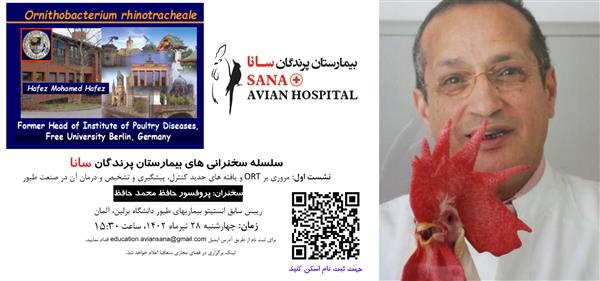Bird Science
تاریخ برگزاری : 1402/04/28

Disease Conditions, Clinical Signs and Treatment Modalities of Large Pet Birds
Percy is back with facts about common diseases in large psittacines and clinical treatment! My name is Hannah and I am 4th year student at Michigan State University, finishing one more year of my curriculum! As an AAV student member, I am awarded a great opportunity to learn more about avian medicine and diversify my clinical practice through the AAV online education library. Here are some review highlights from the module “Disease Conditions, Clinical Signs and Treatment Modalities of Large Pet Birds”:
Fungal pneumonia is a common sequela to circovirus infection, malnourishment, vitamin A deficiency, corticosteroid administration, or immunosuppression in young birds. Poor husbandry and hygiene, such as old wood shavings and seed hulls that often predispose birds to spores.
Primary treatment of fungal respiratory infections can include an IV dose of Amphotercin B for 3-5 days, in addition to terbinafine and fluconazole or itraconazole. Terbinafine 10-15mg/kg PO every 12-24 hours in combination with intraconazole is very effective therapy for Aspergillosis sp. infections and offers a great margin of safety.
Sarcocystis is a pathogen that penetrates and infects the vascular endothelium of the lung, resulting in acute respiratory distress. Treatment should include intensive supportive care and administration of terbutaline to combat bronchial constriction and may include pyrimethamine if diagnosis is determined early.
Infection with Mycobacteria is more common in species such as amazon parrots, finches, brotogerids, and pionus parrots. Muscle wasting, poor body condition and feather quality and weakness are common clinical presentations; lameness associated with bony involvement or increased respiratory effort due to hepatic compression of the air sacs may also be observed.
Multicentric lymphosarcoma is the most common round cell neoplasm that occurs in both passerines and psittacines. Bloodwork derangements typically include abnormalities such as a PCV less than 35%, leukopenia alongside clinical symptoms such scant feces, cutaneous or periorbital swelling, dyspnea, and abdominal swelling. Prognosis is poor as birds do not typically respond well to common chemotherapeutics.
Are you interested in learning more about avian medicine? As an AAV member, you have access to online education modules covering the fundamentals of avian medicine to master classes. It gets even better as you can earn CE! Follow the Associate of Avian Veterinarians on Facebook or Instagram to receive biweekly module summaries provided by two MSU students and the green-cheeked conure, Percy!
Memberships can be purchased here: https://www.aav.org/page/membership
Student membership is just $20 and includes access to over 50 online courses and more!
Once membership is purchased, sign in to access the online education portal and start learning today!
#percypicks
Percy is back with facts about common diseases in large psittacines and clinical treatment! My name is Hannah and I am 4th year student at Michigan State University, finishing one more year of my curriculum! As an AAV student member, I am awarded a great opportunity to learn more about avian medicine and diversify my clinical practice through the AAV online education library. Here are some review highlights from the module “Disease Conditions, Clinical Signs and Treatment Modalities of Large Pet Birds”:
Fungal pneumonia is a common sequela to circovirus infection, malnourishment, vitamin A deficiency, corticosteroid administration, or immunosuppression in young birds. Poor husbandry and hygiene, such as old wood shavings and seed hulls that often predispose birds to spores.
Primary treatment of fungal respiratory infections can include an IV dose of Amphotercin B for 3-5 days, in addition to terbinafine and fluconazole or itraconazole. Terbinafine 10-15mg/kg PO every 12-24 hours in combination with intraconazole is very effective therapy for Aspergillosis sp. infections and offers a great margin of safety.
Sarcocystis is a pathogen that penetrates and infects the vascular endothelium of the lung, resulting in acute respiratory distress. Treatment should include intensive supportive care and administration of terbutaline to combat bronchial constriction and may include pyrimethamine if diagnosis is determined early.
Infection with Mycobacteria is more common in species such as amazon parrots, finches, brotogerids, and pionus parrots. Muscle wasting, poor body condition and feather quality and weakness are common clinical presentations; lameness associated with bony involvement or increased respiratory effort due to hepatic compression of the air sacs may also be observed.
Multicentric lymphosarcoma is the most common round cell neoplasm that occurs in both passerines and psittacines. Bloodwork derangements typically include abnormalities such as a PCV less than 35%, leukopenia alongside clinical symptoms such scant feces, cutaneous or periorbital swelling, dyspnea, and abdominal swelling. Prognosis is poor as birds do not typically respond well to common chemotherapeutics.
Are you interested in learning more about avian medicine? As an AAV member, you have access to online education modules covering the fundamentals of avian medicine to master classes. It gets even better as you can earn CE! Follow the Associate of Avian Veterinarians on Facebook or Instagram to receive biweekly module summaries provided by two MSU students and the green-cheeked conure, Percy!
Memberships can be purchased here: https://www.aav.org/page/membership
Student membership is just $20 and includes access to over 50 online courses and more!
Once membership is purchased, sign in to access the online education portal and start learning today!
#percypicks
